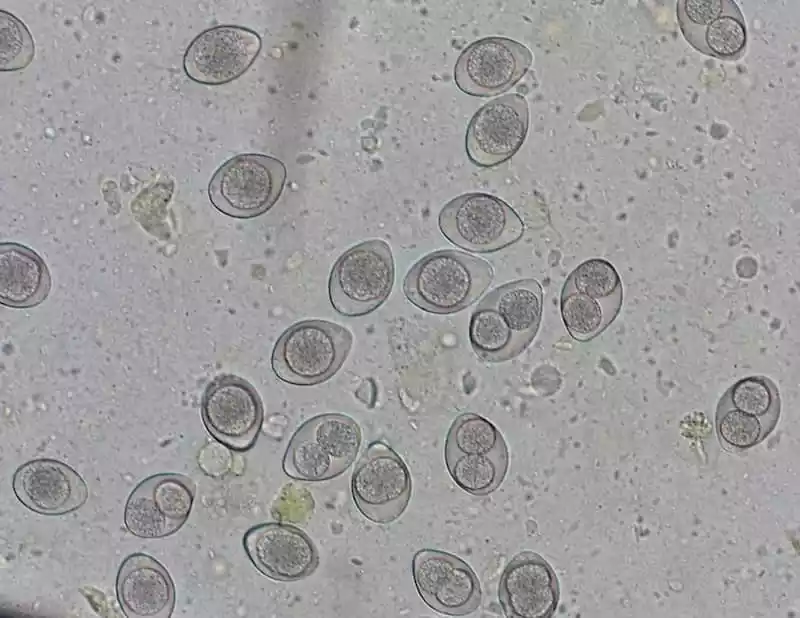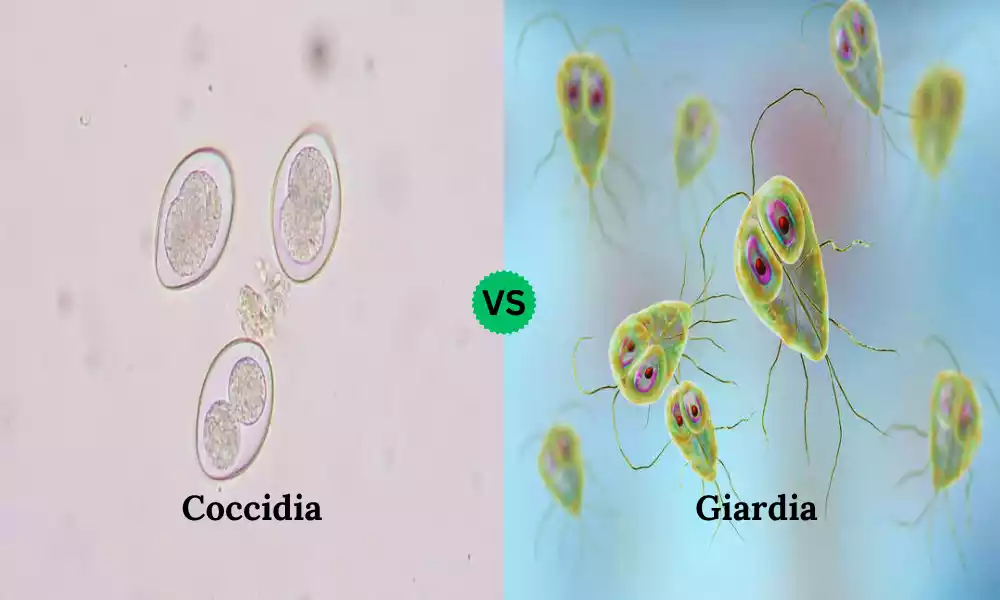Coccidia and Giardia are two common intestinal parasites that affect animals, including dogs and cats. These microscopic organisms can lead to gastrointestinal issues and discomfort in pets. Coccidia and Giardia infections can cause symptoms such as diarrhea, vomiting, and weight loss. Proper understanding, diagnosis, and treatment are crucial to ensure the well-being of our furry companions.
Explanation of Coccidia

Coccidia is a type of protozoan parasite that primarily infects the gastrointestinal tract of animals, including mammals, birds, and reptiles. They belong to the family Eimeriidae and are part of the phylum Apicomplexa, which includes other parasitic organisms like Plasmodium (causative agent of malaria) and Toxoplasma (causative agent of toxoplasmosis).
Characteristics of Coccidia
- Single-Celled Organisms: Coccidia are single-celled organisms, meaning they consist of a single cell that performs all necessary functions for their survival and reproduction.
- Complex Lifecycle: The lifecycle of coccidia involves both sexual and asexual stages. The parasite reproduces within the host’s cells and produces oocysts, which are the infectious stages shed in the host’s feces.
- Host Specificity: Different species of coccidia exhibit host specificity, meaning they tend to infect specific types of animals. For instance, coccidia that infect dogs are different from those that infect cats.
Lifecycle and Transmission
- Infection: Animals become infected by ingesting oocysts, which are the hardy, thick-walled structures produced by the coccidia parasites. These oocysts are shed in the feces of infected animals.
- Spore Formation: Once ingested, the oocysts release sporozoites, which are the infective stages of the parasite. These sporozoites invade the host’s intestinal cells and undergo asexual reproduction, forming new oocysts.
- Oocyst Shedding: The new oocysts are released into the host’s digestive tract and are excreted in the feces, ready to infect other animals if they come into contact with contaminated environments.
Clinical Symptoms
Coccidial infections can lead to gastrointestinal disturbances, including:
- Diarrhea: Often with mucus or blood.
- Dehydration: Due to fluid loss through diarrhea.
- Weight Loss: Reduced appetite and nutrient absorption.
- Lethargy: General weakness and reduced activity.
Diagnosis of Coccidia
- Fecal Flotation: Microscopic examination of fecal samples to identify coccidia oocysts.
- Microscopic Examination: Identification of characteristic structures within the host’s cells, such as schizonts (reproductive forms).
- PCR Testing: Molecular methods can detect coccidia DNA for more accurate diagnosis.
Treatment and Prevention
- Anticoccidial Medications: Drugs such as sulfonamides and amprolium are used to treat coccidial infections.
- Improved Hygiene: Regular cleaning and disinfection of animal living spaces can reduce the likelihood of infection.
- Quarantine Measures: Isolating infected animals from healthy ones prevents the spread of coccidia.
Coccidial infections are a significant concern in veterinary medicine, particularly in animal husbandry and farming industries. Effective management involves understanding the lifecycle and transmission of these parasites, early detection through proper diagnosis, and appropriate treatment and prevention strategies to mitigate their impact on animal health.
Explanation of Giardia

Giardia is a genus of microscopic, flagellated protozoan parasites that can infect the digestive systems of various animals, including humans. Giardia duodenalis, formerly known as Giardia lamblia or Giardia intestinalis, is the species most commonly associated with human infections.
Characteristics of Giardia
- Flagellated Organisms: Giardia parasites possess hair-like structures called flagella, which they use for movement and attachment to the host’s intestinal lining.
- Two Morphological Forms: Giardia alternates between two forms in its lifecycle: the dormant cyst form, which is resistant to environmental conditions, and the active trophozoite form, which is found within the host’s intestine.
Lifecycle and Transmission
- Ingestion: Animals, including humans, become infected by ingesting water or food contaminated with Giardia cysts.
- Excystation: In the host’s stomach and small intestine, the cysts release trophozoites, which are the active, motile forms of Giardia.
- Attachment and Replication: Trophozoites attach to the intestinal lining using their adhesive discs and reproduce through binary fission, where a single organism divides into two.
- Encystation: As trophozoites move further down the intestine, they transform back into cysts, allowing them to survive outside the host’s body.
- Cyst Shedding: Infected individuals shed cysts in their feces, which can contaminate the environment and serve as a source of infection for others.
Clinical Symptoms
Giardia infections can lead to a range of gastrointestinal symptoms, including:
- Diarrhea: Often watery and foul-smelling.
- Abdominal Cramps: Discomfort and pain in the abdominal area.
- Nausea and Vomiting: Especially in severe cases.
- Weight Loss: Due to impaired nutrient absorption.
- Fatigue: Resulting from the overall impact on the digestive system.
Diagnosis of Giardia
- Microscopic Examination: Stool samples are examined under a microscope to identify Giardia cysts or trophozoites.
- Rapid Diagnostic Tests: Immunoassays that detect Giardia antigens in stool samples for quicker diagnosis.
- Molecular Testing: PCR (polymerase chain reaction) can detect Giardia DNA for accurate identification.
Treatment and Prevention
- Antigiardial Medications: Drugs like metronidazole and tinidazole are commonly used to treat Giardia infections.
- Hygiene: Ensuring clean water sources and practicing good hygiene, including handwashing, can prevent the spread of the infection.
- Avoiding Contaminated Water: Avoiding drinking or using untreated water from potentially contaminated sources.
Giardia infections are a significant concern, particularly in areas with poor sanitation and limited access to clean water. Understanding the lifecycle and transmission of Giardia, along with effective treatment and prevention strategies, is essential for controlling the spread of this parasitic infection and maintaining public health.
Comparison Table of Coccidia and Giardia
Here’s a comparison table highlighting the key differences between Coccidia and Giardia infections:
| Aspect | Coccidia | Giardia |
|---|---|---|
| Classification | Protozoan parasites belonging to the family Eimeriidae | Protozoan parasites belonging to the genus Giardia |
| Morphology | Single-celled organisms | Flagellated organisms |
| Infection Route | Fecal-oral transmission via oocysts | Fecal-oral transmission via cysts |
| Lifecycle | Complex, involves asexual and sexual stages | Alternates between cyst and trophozoite stages |
| Host Specificity | Species-specific; various species infect different animals | Can infect a wide range of animals, including humans |
| Clinical Symptoms | Gastrointestinal disturbances, diarrhea, dehydration | Gastrointestinal symptoms, diarrhea, abdominal cramps |
| Attachment to Host | Parasites reside within host’s cells | Parasites attach to intestinal lining |
| Diagnostic Methods | Fecal flotation, microscopic examination | Microscopic examination, rapid tests, PCR |
| Treatment | Anticoccidial medications | Antigiardial medications |
| Prevention | Improved hygiene and sanitation | Clean water sources, hygiene practices |
| Public Health Concern | Common in animal husbandry and farming | Relevant in areas with poor sanitation and water quality |
This table provides a concise comparison, there may be additional details that can be included depending on the level of depth and specificity you want to achieve in your content.
What are the similarities between Coccidia and Giardia?

Coccidia and Giardia are distinct parasites with their own characteristics, lifecycle, and effects on hosts, there are also some similarities between them.
Here are some of the key similarities:
- Protozoan Parasites: Both Coccidia and Giardia are protozoan parasites, belonging to the broader category of single-celled eukaryotic organisms.
- Fecal-Oral Transmission: Both parasites are transmitted through the fecal-oral route, where infectious stages (oocysts for Coccidia, cysts for Giardia) are shed in the host’s feces and can contaminate the environment, leading to new infections when ingested.
- Gastrointestinal Infections: Both parasites primarily infect the gastrointestinal tract of their hosts, causing symptoms related to digestive disturbances, such as diarrhea and abdominal discomfort.
- Water Contamination: Both Coccidia and Giardia infections can result from ingestion of contaminated water, as well as from consuming contaminated food or coming into contact with contaminated surfaces.
- Human Health Impact: Both parasites can infect humans and cause gastrointestinal symptoms, making them significant concerns for public health, especially in areas with poor sanitation and hygiene practices.
- Diagnostic Techniques: Both infections can be diagnosed through microscopic examination of stool samples, allowing for the identification of the respective infectious stages (oocysts for Coccidia, cysts or trophozoites for Giardia).
- Treatment Approaches: Both infections are typically treated using specific medications targeting the parasites. For Coccidia, anticoccidial medications are used, while for Giardia, antigiardial medications like metronidazole are commonly prescribed.
- Preventive Measures: Both infections can be prevented through improved hygiene practices, such as proper sanitation, clean water sources, and effective waste disposal. Avoiding ingestion of contaminated water and food is crucial for preventing both Coccidia and Giardia infections.
While these similarities exist, it’s important to recognize that the parasites have distinct characteristics and lifecycles, leading to differences in their clinical manifestations, diagnostic methods, and treatment strategies. Understanding both the similarities and differences helps in effectively addressing and managing these infections.
Final Thoughts
Being aware of the presence of Coccidia and Giardia is vital for pet owners. These intestinal parasites can cause various health problems in animals, but with early detection, proper veterinary care, and hygiene maintenance, their impact can be minimized. By staying informed and taking proactive measures, we can provide our pets with a healthier and happier life, free from the challenges posed by these parasites.































